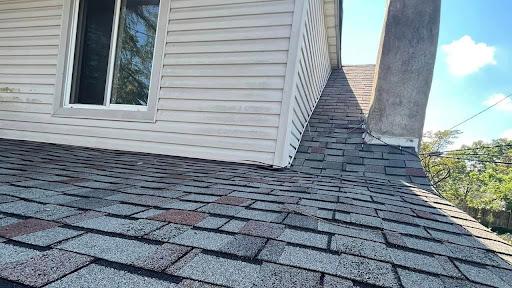Blogs

How Can Different Roofing Materials Affect Home Insulation?
Roofing materials affect home insulation by influencing heat absorption and retention. Reflective materials like metal or white tiles keep homes cooler, while dark shingles absorb more heat, increasing cooling costs. Insulating materials enhance thermal performance by reducing heat transfer.
When choosing a roofing material, homeowners often focus on aesthetics, durability, and cost. However, one crucial aspect that should not be overlooked is how different roofing materials impact home insulation. Insulation plays a pivotal role in maintaining comfortable indoor temperatures and reducing energy costs.
At Northeast Exteriors, a leading roofing company in Palmyra, New Jersey, we understand the importance of selecting the right roofing material to enhance your home's insulation and energy efficiency. In this article, we’ll explore how various roofing materials affect insulation and energy performance, helping you make an informed decision for your home.
Key Takeaways
Asphalt Shingles: Affordable but with minimal insulation; may require additional insulation.
Metal Roofing: Reflective and energy-efficient; reduces cooling costs.
Clay and Concrete Tiles: Excellent thermal mass; moderates indoor temperatures.
Wood Shingles and Shakes: Moderate insulation; requires proper ventilation.
Slate Roofing: Superior insulation; durable and effective temperature regulation.
Color Impact: Light colors reflect sunlight; dark colors absorb heat.
Insulation Types: Fiberglass, spray foam, cellulose; each offers different resistance levels.
Solar Reflectance: High reflectance reduces heat absorption and lowers energy costs.
Maintenance: Regular upkeep essential for preserving insulation performance.
Professional Installation: Ensures optimal function and energy efficiency.
Roofing Materials and Their Insulation Properties
Asphalt Shingles
Asphalt shingles are a popular choice due to their affordability and ease of installation. However, they have minimal insulation properties. Asphalt shingles tend to absorb heat, which can lead to increased indoor temperatures during the summer months. To compensate for their low insulation, additional insulation materials may be required to improve energy efficiency and comfort.
Metal Roofing
Metal roofs, including steel and aluminum, offer superior insulation benefits compared to asphalt shingles. Their reflective nature helps to bounce sunlight away from the home, reducing heat absorption. This reflective quality can lead to lower cooling costs in warmer climates, making metal roofing an energy-efficient option. Additionally, metal roofs can be coated with cool roofing technologies to further enhance their reflective properties.
Clay and Concrete Tiles
Clay and concrete tiles are known for their density and thermal mass. They absorb and store heat effectively, helping to moderate indoor temperatures. In hot climates, they keep homes cooler by absorbing heat during the day and releasing it slowly. Conversely, in cooler climates, they help retain warmth. Their thickness and thermal mass contribute to their excellent insulation performance, making them a versatile choice for various climates.
Wood Shingles and Shakes
Wood roofing materials offer moderate insulation due to their natural composition. Wood shingles and shakes provide some level of thermal resistance, but their insulation performance can vary. Proper ventilation is essential to prevent heat buildup and ensure the effectiveness of wood roofing in warmer climates. Regular maintenance and ventilation systems can enhance their overall insulation performance.
Slate Roofing
Slate is renowned for its durability and superior insulation properties. Its density allows it to effectively regulate indoor temperatures, keeping homes cooler in summer and warmer in winter. Slate's thermal mass contributes to its ability to provide excellent insulation, making it a long-lasting and energy-efficient roofing option.
Additional Factors Affecting Home Insulation
Color of the Roof
The color of roofing materials significantly influences temperature regulation. Light-colored roofs reflect more sunlight, which helps keep homes cooler. In contrast, dark-colored roofs absorb more heat, potentially raising indoor temperatures. Choosing a roof color that complements your climate can enhance energy efficiency and comfort.
Insulation and Ventilation
Proper insulation beneath the roofing materials is crucial for maintaining energy efficiency. Types of insulation include fiberglass, spray foam, and cellulose, each offering different thermal resistance levels. Adequate roof ventilation is also essential to regulate attic temperatures and prevent moisture buildup, which can lead to mold and damage.
Solar Reflectance
Solar reflectance measures how effectively a roofing material reflects sunlight. High solar reflectance materials, often found in cool roofing options, can significantly reduce heat absorption, leading to lower indoor temperatures and energy costs. Opting for roofing materials with high solar reflectance can improve your home's overall energy efficiency.
Maintenance and Installation
Regular maintenance is vital for preserving the insulation properties of roofing materials. Damaged or deteriorating roofing can compromise insulation and ventilation, leading to increased energy consumption. Professional installation ensures that roofing systems function as intended, maximizing their energy efficiency benefits and extending their lifespan.
The Importance of Roof Ventilation in Energy Efficiency
Roof ventilation is essential for maintaining a comfortable indoor climate and boosting energy efficiency. Proper ventilation helps regulate attic temperatures, preventing heat buildup and moisture problems that can damage roofing materials and lead to higher cooling costs. Effective ventilation systems, such as ridge and soffit vents, ensure that your attic stays cooler, which can improve overall home comfort and energy savings.
Key Points:
Temperature Regulation: Prevents excessive heat buildup.
Moisture Control: Reduces mold and damage risks.
Roof Longevity: Extends the lifespan of roofing materials.
Ventilation Types: Ridge vents, soffit vents, and others.
Energy Efficiency: Lowers cooling costs and energy consumption.
How to Choose the Right Insulation for Your Home
Selecting the right insulation is crucial for enhancing your home’s energy efficiency. Insulation materials like fiberglass, spray foam, and cellulose each offer distinct advantages. Consider factors such as R-value, moisture resistance, and installation ease to find the best option for your climate and needs. Proper insulation helps maintain consistent indoor temperatures and reduces energy bills.
Key Points:
R-Value: Indicates insulation effectiveness; higher is better.
Moisture Resistance: Prevents mold and maintains performance.
Types of Insulation: Fiberglass, spray foam, cellulose.
Installation: Assess ease and cost of installation.
Energy Savings: Reduces heating and cooling costs.
Benefits of Cool Roofing for Energy Savings
Cool roofing materials reflect more sunlight and absorb less heat, which can significantly reduce cooling costs and improve indoor comfort. This technology helps to keep homes cooler and can extend the lifespan of roofing materials. Cool roofing also contributes to reducing the urban heat island effect, benefiting both the environment and your energy bills.
Key Points:
Reflectivity: Reduces heat absorption with reflective coatings.
Cooling Costs: Lowers air conditioning demands.
Roof Durability: Extends the lifespan of roofing materials.
Environmental Impact: Mitigates urban heat island effect.
Indoor Comfort: Improves temperature regulation inside the home.
Understanding the Role of Roof Color in Temperature Regulation
Roof color affects how much heat is absorbed or reflected, influencing indoor temperatures and energy efficiency. Light-colored roofs reflect more sunlight, keeping homes cooler and reducing air conditioning costs. Conversely, dark-colored roofs absorb more heat, which can increase indoor temperatures. Choosing the right roof color based on your climate can optimize energy performance and comfort.
Key Points:
Heat Reflection: Light colors keep homes cooler.
Heat Absorption: Dark colors increase indoor temperatures.
Energy Costs: Light roofs lower cooling expenses.
Climate Fit: Choose colors based on local weather conditions.
Efficiency: Enhances overall home energy performance.
FAQs
How does metal roofing affect home insulation? Metal roofing reflects sunlight, reducing heat absorption and lowering cooling costs. Its energy efficiency can help maintain comfortable indoor temperatures.
What are the insulation benefits of clay tiles? Clay tiles provide excellent thermal mass, absorbing and storing heat. They help moderate indoor temperatures, keeping homes cooler in summer and warmer in winter.
Do asphalt shingles provide good insulation? Asphalt shingles have minimal insulation properties and tend to absorb heat. Additional insulation may be required to enhance energy efficiency.
How does the color of a roof impact energy efficiency? Light-colored roofs reflect more sunlight, keeping homes cooler, while dark-colored roofs absorb more heat, potentially increasing indoor temperatures.
Why is roof ventilation important for insulation? Proper roof ventilation helps regulate attic temperatures, preventing heat buildup and moisture accumulation. It contributes to better insulation and energy efficiency.
Optimize Your Home’s Comfort with Northeast Exteriors
Choosing the right roofing material is essential for optimizing your home’s insulation and energy efficiency. Different materials offer varying benefits, from the reflective properties of metal roofing to the thermal mass of clay tiles. At Northeast Exteriors, we are committed to helping homeowners make informed decisions that enhance their comfort and energy savings.
Northeast Exteriors is here to provide expert guidance and top-notch roofing solutions tailored to your needs. Contact us now to schedule a consultation and discover how our professional team can help you achieve optimal comfort and savings. Don’t wait—reach out today and start your journey to a more efficient home with Northeast Exteriors!
Hours
Monday: 8:00AM - 6:00PM
Tuesday: 8:00AM - 6:00PM
Wednesday: 8:00AM - 6:00PM
Thursday: 8:00AM - 6:00PM
Friday: 8:00AM - 6:00PM
Copyright © Northeast Exteriors 2023. All Rights Reserved. Privacy Policy. Terms & Conditions. Web Design by Fused Media





